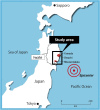Association between relocation and changes in cardiometabolic risk factors: a longitudinal study in tsunami survivors of the 2011 Great East Japan Earthquake
- PMID: 27173815
- PMCID: PMC4874105
- DOI: 10.1136/bmjopen-2016-011291
Association between relocation and changes in cardiometabolic risk factors: a longitudinal study in tsunami survivors of the 2011 Great East Japan Earthquake
Abstract
Objectives: The aim of this study is to determine changes in atherosclerotic cardiovascular risk factors with and without serious disaster-related mental and socioeconomic problems represented by relocation (REL).
Design: A longitudinal survey.
Setting: Multiphasic health check-ups for the general population affected by the 2011 Great East Japan Earthquake and Tsunami.
Participants: A total 6528 disaster survivors in heavily tsunami-damaged municipalities were recruited. Two sequential surveys were conducted and the data were analysed.
Main outcome measures: Multiphasic health check-ups including investigation of lifestyle and psychological and socioeconomic measures were performed in two sequential phases (8 and 18 months) after the disaster for tsunami survivors with REL (n=3160) and without REL (n=3368). Longitudinal changes in cardiometabolic risk factors between the two phases were compared in the REL and non-REL groups.
Results: In sex/age-adjusted analysis, we found increases in body weight and waist circumference between the two phases that were significantly greater in the REL group than in the non-REL group (body weight:+0.31 (0.23∼0.39) versus -0.24 (-0.32∼-0.16) kg, p<0.001; waist circumference:+0.58 (0.48∼0.68) versus+0.05 (-0.05∼0.15) cm, p<0.001)). A decrease in serum HDLC levels was found and again was significantly greater in the REL group than in the non-REL group (-0.65 (-0.96∼-0.34) versus -0.09 (-0.39∼0.21) mg/dL, p=0.009). In addition, deterioration in physical activity, mental health and socioeconomic status was more prevalent in the REL group than in the non-REL group (all p<0.001).
Conclusions: This study suggests that relocation after the devastating tsunami was related to weight gain and decreasing HDLC among survivors, and this change was associated with prolonged psychological distress and socioeconomic problems after the disaster.
Keywords: EPIDEMIOLOGY; PREVENTIVE MEDICINE; PUBLIC HEALTH.
Published by the BMJ Publishing Group Limited. For permission to use (where not already granted under a licence) please go to http://www.bmj.com/company/products-services/rights-and-licensing/
Figures



References
-
- The National Police Agency, Japan. Damage Situation and Police Countermeasures associated with 2011Tohoku district—off the Pacific Ocean Earthquake. 2015. [updated 10 December 2015; cited 3 January 2016]. https://www.npa.go.jp/archive/keibi/biki/higaijokyo_e.pdf
Publication types
MeSH terms
Substances
LinkOut - more resources
Full Text Sources
Other Literature Sources
Medical
